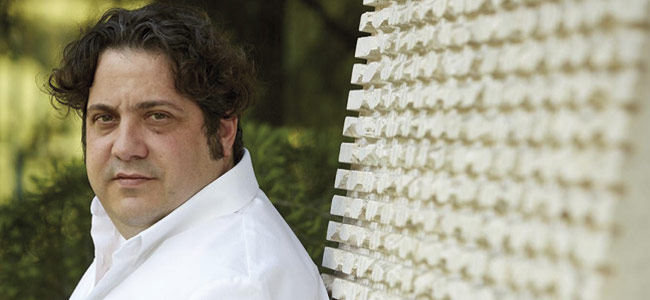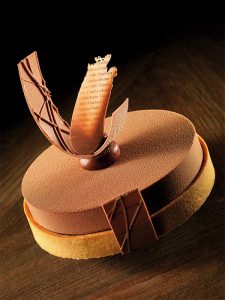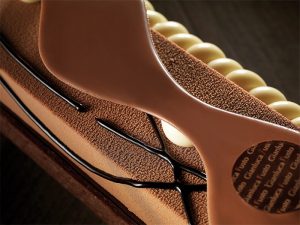Categories Pastry Chef Articles
Gianluca Fusto: “Beauty without taste is not beautiful”

His mother passed on a passion for taste and good food. But when Gianluca Fusto first entered a professional kitchen, at the Savini Ristorante in Milan, he was fascinated by pastry, ‘it happened to me as if I were John Belushi in The Blues Brothers, I saw the light. And I have not wanted to leave this sweet world full of creativity’, the chef recalls. After traveling the world, Fusto has now anchored himself in Milan, with a project that gathers a school, workshop, and pastry shop in the same space. There he intends to continue paying homage to beauty, that which provokes ‘pleasure for the eyes (our second mouth!), like the one that is enjoyed in the tasting’, says the chef.
Photos: Giovanni Panarotto
What is Gianluca Fusto doing now?
Last May I published my latest book: MONO. Le monoporzioni in pasticceria. My personal approach to the wonderful world of what until yesterday was considered simply small cakes (Ed. Italian Gourmet). I have the agenda full of commitments around the world (consultations, courses, events…). But there is great news: Gianluca Fusto becomes FUSTO Milano. In these years my life has changed, I have gone from a pastry chef with a suitcase to having a family and a more articulated structure. The natural step is, therefore, to concentrate all these years of experience and share them in my own creative center in Milan, FUSTO Milano. A school, workshop, and pastry chef in the heart of the Milanese design area that we hope will be ready soon.
You said that pastry cannot just be the search for aesthetics, but, like cuisine, it should be more concerned with the origin of the ingredients, the producers, etc. Can you expand this reasoning?
I’ve always thought this. I come from a long experience in the restaurant business, before my time in pastry and chocolate. Seasonality, origins, sustainability… If we think, for example, of cocoa beans, human and environmental factors are fundamental. My style is based on a rule of three: three main ingredients, three structures, three temperatures…
The aesthetic part strengthens the message I want to convey, it is designed according to the pleasure of the eyes (our second mouth!), but also according to the tasting, how we want our creation to be experienced. Beauty without taste is not beautiful, but a dessert without a creative and technical project is likely to be false.
“The trends that I like the most are those related to the naturalness of the ingredients, the control of sugars and fats, and the maximum selection of ingredients”
 Where is artisan pastry heading towards? How do you think it will be in the future?
Where is artisan pastry heading towards? How do you think it will be in the future?
Artisan pastry has in itself a human factor –and a heat– which is hardly replaceable, and this uniqueness will save it. Now, with social networks, it is easy to be up to date in the ‘state of the art’ (and, sometimes, even become standardized). I think everyone should try to express their style and culture better. The trends that I like the most are those related to the naturalness of the ingredients, the control of sugars and fats, and the maximum selection of ingredients, to offer our customers good, recognizable, and impeccably prepared products.
How would you define your pastry? What is your creative philosophy? What is the concept?
As I said my pastry is born from a project and follows a rule, the rule of THREE which allows me to have a consistency even when I have to face different cultures. In my recipes, there is always an ingredient of the place where I am, in addition to an Italian ingredient, which characterizes me, and a technical one. I would define my pastry as ‘projective’ because it is very reflective and technical, and often my creations are linked to small and sweet architectures. But it is also ‘artistic’ because I firmly believe in the spontaneous creative act, in the whirlwind of taste that suddenly emerges as a synthesis of unconscious experiences. I firmly believe in the gourmandise. As a dear friend says, I believe in ‘good, clean and fair’. All this is very Fusto. The new logo of FUSTO Milano includes these concepts and much more.
“I believe in good, clean and fair. All this is very Fusto. The new FUSTO Milano logo includes these concepts and much more”
Where does your inspiration come from?
Without a doubt from my journeys, and therefore, from the people I meet. Places, scents, discoveries… everything is translated into ingredients, aromas, and techniques. Then I try to document myself continuously. I have a library full of different areas, music, art, photography… with my wife Linda we are always looking for new ideas, new observation points, whether in a museum, on a mountaintop, or in a skyscraper. Then I must admit that the creative process takes place naturally, my mental encyclopedia of tastes and techniques has been established over the years, and as soon as I have an idea, I try to write it down if I cannot give it form immediately.
Tell us about the creations you present in so good.. magazine. How would you define them?
They are part of my CROSTATE studio, which I love so much and in which I have worked in recent years. The ‘crostates’ (tartlets) are the cakes which are dear to my heart and of millions of Italians, all grandmothers and mothers have prepared them in our childhood. I wanted to clarify that old aura and turn this sweet platform into something creative, futuristic, and contemporary. And with the help of technique, the deepest vision, the right molds, I think I have achieved my goal. Today, modern tartlets fill the showcases of the best pastry shops, with all their splendor of forms and ingredients. For SO GOOD, I have focused on chocolate, my favorite ingredient, with design and very tasty creations such as MAKIE, whose glaze is inspired by the varnishing technique (hence the name) that I have seen in Japan, a country that I really like.
You will find two Fusto’s recipes in so good #19




